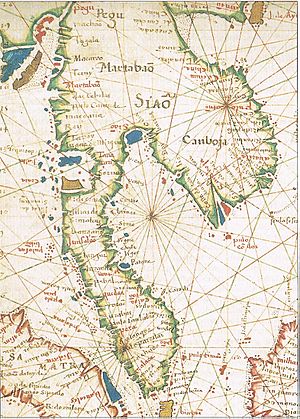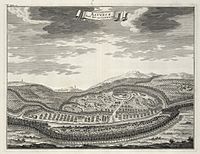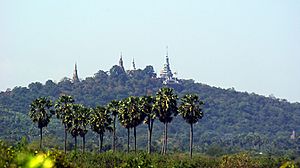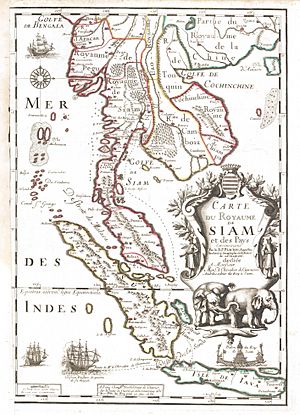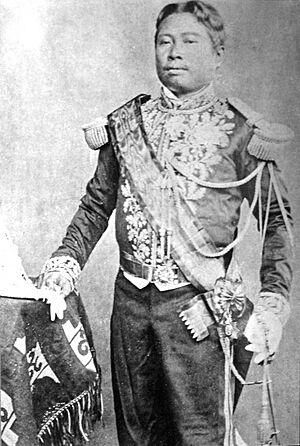Post-Angkor period facts for kids
Quick facts for kids
Kingdom of Cambodia
ក្រុងកម្ពុជាធិបតី
Krŏng Kâmpŭchéathĭbâtei |
|||||||||
|---|---|---|---|---|---|---|---|---|---|
| 1431–1863 | |||||||||
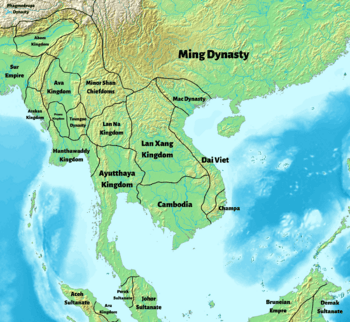
Cambodia and mainland Southeast Asia in 1540 CE
|
|||||||||
| Capital |
|
||||||||
| Common languages | Middle Khmer (until 1777) Khmer |
||||||||
| Religion | Buddhism | ||||||||
| Government | Absolute monarchy | ||||||||
| King | |||||||||
|
• 1431–1463
|
Ponhea Yat (first) | ||||||||
|
• 1860–1863
|
Norodom (last) | ||||||||
| Historical era | Early modern period | ||||||||
|
• Siege of Angkor
|
1431 | ||||||||
|
• Siamese invasion
|
1594 | ||||||||
|
• French protectorate
|
11 August 1863 | ||||||||
| Population | |||||||||
|
• 1500
|
1,200,000 | ||||||||
|
• 1700
|
1,650,000 | ||||||||
| Currency | Tical | ||||||||
|
|||||||||
| Today part of | Cambodia Thailand Vietnam |
||||||||
The post-Angkor period of Cambodia (Khmer: ប្រទេសកម្ពុជាក្រោយសម័យអង្គរ), also known as the Middle Period or Dark Age, was a time in Cambodian history. It lasted from the early 15th century until 1863. This was when France took control of Cambodia.
Historians are still trying to fully understand why the great Khmer Empire declined. Many things likely played a part. These include changes in religion, ruling families, and how the government and army worked. Environmental problems like floods and droughts also contributed.
During this time, stone writings in temples, which usually tell us about Khmer history, became very rare. Records of the kings also stopped for over 200 years. Building large temples like those in Angkor also stopped. Most of what we know about the 15th century comes from outside Cambodia. These are mainly Chinese and Thai records.
A key event was a Siamese (Thai) attack on the capital, Yasodharapura (Angkor Thom), around 1431. After this, Cambodia's main political center moved south. It went to river port areas like Phnom Penh and later Longvek.
More information is available for the 16th century. The kingdom was centered near the Mekong River. It became an important part of the Indian Ocean trade network. This is how Europeans first made contact with Cambodia. Wars with Siam led to Cambodia losing land in the west. The capital, Longvek, was captured in 1594. The Vietnamese also expanded south, reaching Saigon in the 17th century. This started Cambodia's slow loss of access to the sea and independent trade.
Siam and Vietnam became more powerful in the 17th and 18th centuries. This often forced the Cambodian kings to move their capital. The kings became less powerful, almost like vassals (rulers under another's control). Both Siam and Vietnam demanded loyalty and gifts from Cambodia. By the early 19th century, Cambodia had lost its independence. To prevent Siam or Vietnam from fully taking over, King Ang Duong accepted help from France. This led to France taking control of Cambodia in 1863.
Contents
Why Did the Khmer Empire Decline?
The Khmer Empire was very powerful in Southeast Asia for many centuries. It often fought with its neighbors, like the Pagan Kingdom to the west and Champa to the east. The Khmer and Cham kingdoms, both Hindu, often tried to control each other. The Khmer kings sometimes aimed to conquer Cham ports, which were important for trade. Even after big defeats, like the Cham invasion of Angkor in 1177, the empire usually recovered quickly.
Around the 12th century, people from the Tai group moved south from China. They settled in what is now Thailand. This led to the creation of the Sukhothai Kingdom and later the Ayutthaya kingdom. These new kingdoms grew and took over Khmer lands.
Battles and Invasions
Records from Cambodia and Thailand mention many battles and raids. However, some historians, like David P. Chandler and Michael Vickery, question how accurate these old texts are. Other historians disagree with this view.
David Chandler notes that Cambodian records before 1550 might not be reliable. They were sometimes copied from Thai records. The timeline of Cambodian history might also be shaped to focus on Angkor. Thai records have similar issues.
Siamese records mention attacks in 1350, around 1380, 1418, and 1431.
- In 1350, the Siamese attacked Angkor and took many families back to their capital.
- Around 1380, the Cambodian ruler attacked Thai areas, taking thousands of people. The Thai king then attacked Cambodia.
- In 1418, the Thai king attacked and captured Angkor again.
People or Land?
Siamese sources often mention taking many people from defeated cities. This might have sped up the cultural decline of the conquered areas.
Historian Michael Vickery questions if the Siamese wanted people or control over rich farmlands. He suggests that rulers in early Southeast Asia might have been more interested in controlling land than people.
However, other historians believe that manpower was very important. After wars, the winning side often took many people from the defeated area. Whole villages were sometimes moved. These people then became part of the winning kingdom's population. This was especially true in areas where land was plentiful but labor was scarce.
Changes in Religion and Rulers
The Khmer kingdom slowly changed its ruling family. The new Mahidharapura dynasty, which started around 1080, struggled to gain full control. They also changed some old traditions.
Over time, Mahayana Buddhism became more accepted. Several Buddhist kings ruled, like Jayavarman VII. These kings did not see themselves as divine gods. This changed how people viewed royal power. It led to a loss of respect for the ruling family compared to foreign rulers. People started to focus more on Buddhist teachings.
Later, King Indravarman III (around 1295-1308) made Theravada Buddhism the state religion. This religion focuses more on individual responsibility to gain good karma and reach nirvana.
Historians also point out that there were many rivalries and power struggles among royal family members. Periods of strong rule were often followed by times when power was spread out. Few rulers could control the whole kingdom.
Environmental Challenges
Many historians now believe that the decline was also caused by problems with Angkor's complex water system. This system of canals and reservoirs was used for irrigation. Recent studies show that the system was overused and started to fill with dirt. This was made worse by large-scale cutting down of trees.
Building and maintaining many temples also put a huge strain on the kingdom's resources. It took thousands of workers away from farming and other public works. This also led to less tax money.
Water was essential for Angkor. If the water supply was disrupted, it would be disastrous. New technologies like LIDAR (Light Detection and Ranging) scans of Angkor have shown new information. Studies of tree rings also suggest long periods of drought in the 14th and 15th centuries. This means that interactions between humans and the environment, including natural disasters, played a big role in the empire's decline.
Chaktomuk Era: A New Capital
After the old capital of Yasodharapura (Angkor) was left, the remaining Khmer people, with help from Siam, built a new capital. This new city was about 200 kilometers southeast, where modern-day Phnom Penh is located. It was at the meeting point of the Mekong River and the Tonlé Sap river.
This new location helped control river trade from the Khmer heartland, upper Siam, and Laos. It also had access to international trade routes through the Mekong Delta. Unlike the old inland capital, this society was more open to the outside world. It relied mainly on trade for wealth. Trading with China during the Ming dynasty (1368–1644) brought good opportunities for Cambodian leaders who controlled royal trade.
Even though the capital moved, the temples at Angkor remained very important for the nation's religious life.
Longvek Era: Trade and European Contact
King Ang Chan I (1516–1566) moved the capital from Phnom Penh north to Longvek. This city was on the banks of the Tonle Sap river. Trade was very important here. Cambodian ports thrived in the 16th century. They traded items like precious stones, metals, silk, cotton, incense, ivory, and rhinoceros horn.
First Contact with Europeans
The first official contact with Europeans happened in 1511. Messengers from the Portuguese admiral Alfonso de Albuquerque arrived in Indochina. By the late 16th and early 17th centuries, Longvek had many communities of traders from different countries. These included Chinese, Indonesians, Malays, Japanese, Arabs, Spanish, English, Dutch, and Portuguese.
Christian missionaries also started arriving in 1555. The first was a Portuguese priest named Gaspar da Cruz. However, he was not very successful in spreading Christianity.
Siamese Attacks
Cambodia was attacked by the Thai prince Naresuan in 1583. Longvek was captured in 1594. This marked the first time a foreign power had significant political control over Cambodia. The Cambodian king became a vassal. After Longvek was captured, Cambodian royals were taken to the Thai court in Ayutthaya. They were kept under Thai influence.
Some Cambodian royals escaped to Laos. However, their children, raised in Laos, became rivals with their relatives in Siam. They even had the ruling Cambodian king killed with the help of Spanish and Portuguese sailors. This led to more conflicts, including the Cambodian–Spanish War. This pattern of royal struggles continued for centuries. Foreign powers often interfered in royal marriages and disputes. This made it hard for Cambodia to have a strong, independent king.
Srey Santhor Era
Kings Preah Ram I and Preah Ram II moved the capital several times. They established their royal capitals at Tuol Basan (Srey Santhor), about 40 kilometers northeast of Phnom Penh. Later capitals included Pursat, Lavear Em, and finally Oudong. In 1596, Spanish and Portuguese soldiers from Manila attacked and destroyed Srei Santhor. In 1597, Malay Muslim merchants killed the Spanish soldiers who tried to conquer Cambodia.
Oudong Era
By the 17th century, Siam and Vietnam were increasingly fighting for control of the fertile Mekong basin. This put more pressure on weakened Cambodia. The 17th century also marked the start of direct relations between Cambodia and Vietnam. This included wars between the Nguyễn lords in southern Vietnam and the Trịnh lords in the north.
A French explorer, Henri Mouhot, described Oudong in 1864. He noted the busy streets with officials, slaves, horsemen, and carts. He also saw elephants and religious processions. The city had about 12,000 people.
Losing the Mekong Delta
By the late 15th century, the Vietnamese had conquered some territories of the Champa kingdom. Many surviving Chams moved to Khmer territory.
In 1620, the Vietnamese expanded south into the Mekong Delta, which was then Khmer land. Also in 1620, the Khmer king Chey Chettha II married a daughter of a Vietnamese lord. Three years later, King Chey Chettha allowed Vietnam to set up a customs post at Prey Nokor (modern-day Ho Chi Minh City). By the end of the 17th century, Vietnam fully controlled this region. Cambodia's access to international sea trade was now limited by Vietnamese taxes.
Some stories, like a Cambodian king falling in love with a Vietnamese princess who then gained the Mekong Delta for Vietnam, are folklore. Historians say these stories are not in the official Cambodian records.
In 1642, Cambodian prince Ponhea Chan became king. He was helped by Malay Muslim merchants. He converted to Islam, changed his name to Ibrahim, and ruled as Ramathipadi I. His reign was a high point for Muslim rule in mainland Southeast Asia.
Ramathipadi defeated the Dutch East India Company in naval battles in 1643 and 1644. The Dutch ambassador was killed, and it was two centuries before Europeans played a major role in Cambodian affairs again. The Dutch left their trading posts in Cambodia in the 1670s. The first Vietnamese military intervention happened in 1658-59. This was when Ibrahim Ramathipadi's own brothers asked for Vietnamese help to remove him and bring back Buddhism.
Siam, which might have been an ally against Vietnam, was busy fighting Burma in the 18th century. In 1767, the Siamese capital of Ayutthaya was destroyed. However, Siam recovered and soon took control of Cambodia again. The young Khmer king Ang Eng (1779–96) was made king at Oudong. Siam took Cambodia's Battambang and Siem Reap provinces. Their local rulers became vassals under direct Siamese rule.
In the early 19th century, Siam and Vietnam fought again for control of Cambodia. Vietnam gained dominance over the Cambodian king. King Ang Duong wanted Cambodia to be independent from both Thailand and Vietnam. He sought help from the British in Singapore. When that failed, he asked for help from the French.
Attempts to force Cambodians to adopt Vietnamese customs led to several rebellions. The biggest one was from 1840 to 1841.
Siam and Vietnam had different views on Cambodia. The Siamese shared a common religion, stories, and culture with the Khmer. They had adopted many Khmer practices. The Thai kings saw themselves as ideal rulers who ruled kindly. The Vietnamese, however, saw the Khmer people as less developed. They viewed Khmer lands as places for Vietnamese settlers.
The Mekong Delta became a disputed area between Cambodians and Vietnamese. Cambodia slowly lost control of it. By the 1860s, French colonists took over the Mekong Delta. They established the colony of French Cochinchina.
What Happened Next?
European Colonialism
In 1861, France officially took control of three provinces in Cochinchina. This marked the beginning of French colonial rule in Southeast Asia. France wanted to create a trade network in the region using the Mekong River. They hoped it would connect to the large market of southern China.
Some historians argue that France's actions were a reaction to British expansion in India and China. France wanted to prevent Britain from gaining too much power. To save Cambodia's independence, King Ang Duong secretly asked France for protection.
In June 1884, the French governor of Cochinchina, Charles Thomson, went to Phnom Penh. He demanded that King Norodom sign a treaty. This treaty would bring big changes, like ending slavery and allowing private land ownership. It would also place French officials in Cambodian cities. The king reluctantly signed the agreement. In 1887, the Indo-Chinese Union was formed, which included Cambodia.
Looking Ahead
Studying Cambodia's ancient past is still quite new. New technologies like LIDAR scanning are revealing new information. Studies on climate and environmental changes have also become more common. It takes time to understand all these new findings. Historians and archaeologists are now paying more attention to how the environment and climate affected Angkor's history.
There are still many debates about the historical sources. There are often big contradictions. A major challenge is to combine research from Cambodia with that from neighboring countries. Some sensitive issues, like border disputes and cultural heritage, are still politically important and not yet solved. A full understanding of this historical period, with all its factors, is still a goal for the future.
Historians hope that combining archaeological research with careful study of old documents will help us understand how ancient Cambodia changed and survived.
Images for kids
See also
 In Spanish: Edad Oscura Camboyana para niños
In Spanish: Edad Oscura Camboyana para niños



